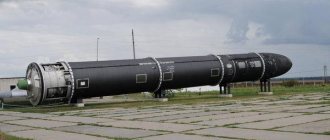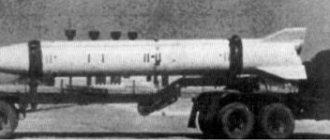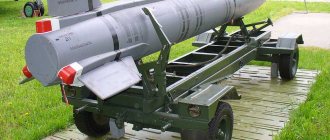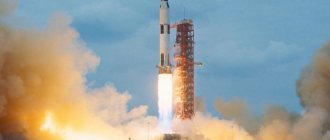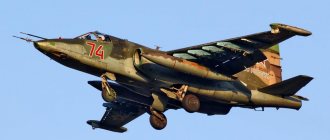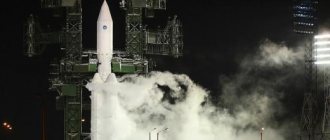A rocket is an aircraft that moves in space due to the action of jet thrust, which occurs as a result of the rejection of part of the working fluid (its own mass) of the device and without the use of substances from the environment. Since rocket flight does not necessarily require the presence of a surrounding gas or air environment, it is possible both in the atmosphere and in a vacuum. The concept of “rocket” can include a wide range of flying objects: from a festive firecracker to a space launch vehicle.
The word missile in military terminology refers to a class, most often, of unmanned aerial vehicles used to destroy distant targets and using the principle of jet propulsion for flight. Due to the wide variety of uses of missiles in the armed forces, by different branches of the military, a wide class of different types of missile weapons has emerged. But when was the first space rocket launched? This is exactly what we will tell you below.
The world's first submarine missile system D-1
For the first time in the world, September 16, 1955.
from a submarine in the presence of S.P. Queen, a ballistic missile was launched. 43 years passed, and in 1998. artificial Earth satellites were launched from a submarine in the same area from an underwater position. Little is known about this side of the work of the brilliant designer, probably because, having worked on this topic, he passed it on to his student, the future general designer, and then simply the leading designer, Viktor Petrovich Makeev. Back on November 27, 1950 The Ministry of Armaments turned to S.P. Korolev on the possibility of creating long-range ballistic missiles for the Navy, and already on January 12, 1951. S.P. Korolev sends his proposals.
January 26, 1954 A government decree was issued to study the issue of the possibility of launching ballistic missiles from submarines. By the summer of 1955. The AB-611 submarine was ready. At the Kapustin Yar cosmodrome, development and testing of the R11-FM rocket was underway on a rocking stand. The prototype of the fleet's first ballistic missile was the first operational-tactical missile S.P. Queen P11, which he began developing in 1950. A characteristic feature of the rocket was that it could be stored and transported while fueled. It was a single-stage R11-FM missile, which had a range of 150 km and an in-flight warhead with an atomic charge. The launch was carried out on the surface.
Almost immediately to the creation of naval ballistic missiles S.P. Korolev involved OKB-385, headed by the 29-year-old future General Designer of Navy Ballistic Missiles, academician and winner of many awards, Viktor Petrovich Makeev. Currently, there is a missile center named after Makeev in the Ural city of Miass.
As Izvestia reported on June 30, 1998, in agreement with the University of Berlin State Research Center named after. Makeeva launches German artificial Earth satellites from our submarines from under water. This is all ahead, but then, in 1955. everything was just beginning. As S.S. writes Kryukov in the book “Roads into Space” (M.: MAI, 1992): “The first test, which took place in the White Sea, turned out to be unsuccessful. Korolev was on this submarine. They gave the command to start, the command to pressurize the tanks passed, but the engine did not start. And so the rocket with working gas generators in the fuel tank and oxidizer tank was tilted from the submarine and thrown overboard.”
September 16 morning S.P. Korolev goes down into the submarine and asks to delay the launch, because... The sea is calm, and it is advisable to carry out tests in rough seas. By lunchtime the wind picked up. The “Start” button is located in the central post of the boat, and it can only be pressed at the command of S.P. Queen. For the first time in the history of rocket science, people are located a few meters from the rocket, and not at a distance in bunkers. The backs of the sailors of the launch team touch the armor of the silo, by opening the hatch of which you can reach the rocket with your hand. S.P. Korolev is on a folding chair. People somehow calmed down and began to work more confidently. Boat commander F.I. Kozlov announces a combat alert, and the boat goes on a combat course. This is how A.A. describes this moment. Zapolsky in his book “Rockets Launch from the Sea” (St. Petersburg, Malachite, 1994). “... Sergei Pavlovich commands clearly, slightly muffled, with a soft pronunciation of the letter “G.” ... The last minutes are ticking by... The boat approaches the starting point. Sergei Pavlovich Korolev commands:
- 5-minute readiness!
The rocket is above the boat and sways with it.
- Attention! Start!
— There is a lifting contact!
The rocket took off from the table. This happened at 17:00. 32 min. September 16, 1955
Launch of the R11-FM from the B-67 submarine during testing in the White Sea
After testing and several more launches from the boat, S.P. Korolev conveys this theme completely to V.P. Makeev and moves on to his space projects. In the future, he did not return to naval topics, but zealously followed how the creation of naval ballistic missiles developed, and helped with advice. Under conditions of the strictest secrecy, many did not know about these works of S.P. Queen, and nowhere is there any mention of his campaigns with submariners and missile launches from a submarine.”
Nowadays, launching satellites from submerged submarines has become commonplace. The creation of underwater spaceports began in the mid-50s of the last century. Russia was a pioneer in this. The question of the possibility of using a ballistic missile from a submarine was raised to OKB-1 S.P. Queen on November 27, 1950, and on July 14, 1953. S.P. Korolev proposes tactical and technical specifications for the R11-FM submarine-missile complex. And years of developments and approvals began. January 26, 1954 A resolution of the USSR Council of Ministers was issued “On carrying out work to study the possibility of launching a ballistic missile from submarines, as well as to create the first combat submarines armed with naval ballistic missiles.”
This is how the creation began, which included the AB-611 project submarine and the R-11FM ballistic missile.
Global rocket
Seventy years ago, on August 29, 1949, the first test of the RDS-1 atomic bomb took place at the Semipalatinsk test site. After many years of effort, the Soviet Union finally acquired a weapon that reliably guaranteed its sovereignty and put it on par with the leading powers of the world. However, in those years, a new stage of geopolitical confrontation began, which also affected near-Earth space.
Space bomb
The autumn of 1957 shook the world. On October 4, Soviet rocket scientists launched the first artificial Earth satellite into orbit. We are accustomed to perceive this date with good feelings as a “small” day of cosmonautics, but the older generation in Western countries still remembers the horror that gripped politicians, military men and journalists when the understanding came: a satellite over the planet is not another act of Soviet propaganda, but a real technology that will likely have military applications. The press of that time was filled with confusion from the realization of a threat that had nothing to counter. For example, the American newspaper Reading Eagle wrote on October 5:
“The Soviets have shown that they beat us in the race to acquire an intercontinental ballistic missile, which they call the 'ultimate weapon.' Some senior US officials have reported that the launch of the Soviet Sputnik appears to mean that the USSR does in fact possess ICBMs.
Time will tell what impact this superiority will have on countries that are less developed than the USSR or the USA. But states looking for a place in the competition between East and West will think twice before getting too close to the United States if the USSR becomes an equal or more powerful military force.”
Although Soviet scientists, well-known in the West, immediately declared that the satellite was of purely scientific value and was quite primitive in design, experts began to wonder what it carried on board besides a radio transmitter. Intelligence equipment? Or an atomic charge?
Launch of the first artificial Earth satellite PS-1 by the R-7 rocket. October 4, 1957, Tyura-Tam training ground (future Baikonur). RSC Energia.
The problem was that in the American public space, unlike the Soviet one, aspects of the military use of near space and the Moon were always eagerly discussed. This “by default” implied the superiority of the United States, which, of course, would be the first in low-Earth orbits and would be able to use it as a new springboard to counter the “red threat.” As a result, when the USSR clearly demonstrated that the real balance of power was not so clear, it immediately began to be suspected of having plans hatched by the American “hawks.” On October 8, news editor George Garrott wrote in St. Petersburg Times:
“The longer the Soviet satellite circles the Earth, the more it becomes a political, propaganda and possibly military achievement, influencing the entire world from its orbit.
Soviet scientific achievement puts the USSR in a dominant position in the disarmament negotiations currently underway at the United Nations. The United States is revising plans to be submitted on behalf of the Western Allies, but the basis of these plans has already been rejected by the USSR during long, inconclusive conferences in London.
UN members will listen politely to Western proposals, but their eyes will be fixed, both figuratively and literally, to the skies to see what the USSR is doing. <…>
The very thought of a hydrogen bomb on some satellite of the Earth, which, with the help of remote control from Moscow, could be released at any point in the calculated orbit, is enough to terrify anyone. This thought will undoubtedly be on the minds of the UN delegates as they listen first to Western disarmament proposals and then to Soviet counterproposals.
The USSR is now in exactly the same position as the United States was in immediately after the explosion of the first atomic bomb, when it became the only country in the world to possess it.
The United States will undoubtedly launch Sputnik and break the Soviet monopoly, just as the USSR and Britain broke the US monopoly on atomic bombs.
But as long as the Soviet monopoly is intact, the USSR will have a strong influence on the United Nations. This influence is not only from a political and propaganda point of view, but also from a position of military strength that forces all countries to listen."
A full-size model of Sputnik 1 (PS-1) at the National Museum of the United States Air Force at Wright-Patterson Air Force Base, Ohio. nationalmuseum.af.mil
In fact, at that time, Soviet rocket scientists had not yet even discussed the possibility of placing atomic or thermonuclear charges on orbital platforms. Their main task was to supply the USSR with a sufficient number of intercontinental carriers capable of reaching US territory. But paradoxically, the activity of the American military, who sought to neutralize a hypothetical threat, contributed to the emergence of weapons that still look like pure fantasy.
Khrushchev's bluff
Since 1955, the United States has been developing the Nika Zeus missile defense system, the creation of which, as many American politicians believed, would devalue the nuclear missile potential of any hostile country.
Soviet specialists closely followed the development of this program and, of course, thought about what means could be used to overcome the US missile defense system. Relying on Western sources, where the idea of orbital bombers was periodically discussed, in 1961 Sergei Pavlovich Korolev, who headed the Special Design Bureau No. 1 (OKB-1), proposed the concept of a “global rocket” (GR). The idea was to equip a nuclear warhead with a braking engine, like a spaceship, launch it into orbit and, if necessary, upon a signal from a ground control station, bring it down in the target area. The advantage of such a scheme over conventional intercontinental ballistic missiles was obvious: it had no restrictions on range and direction - any object on the planet became available for strike.
R-9 missile on a launcher. RSC Energia.
The GR-1 project considered the intercontinental two-stage rocket R-9 (8K75), which Korolev's bureau had been designing since May 1959, and which was supposed to replace the R-7, as the basis for creating a carrier. The fact is that the “seven”, which went down in history as the first space rocket, was poorly suited for combat duty: it had to be assembled from separate blocks, refueled with fuel components for a long time, and then either be launched immediately or removed from the launch complex before next time. The missile intended for attack had to be stored fueled for at least a year and launched within minutes, not hours.
To meet the requirements of the army authorities, OKB-1 employees abandoned the parallel arrangement of stages, adopting a more traditional option - a sequential design. The dimensions of the R-9 were chosen so that it could be transported by rail on one platform and placed in the Desna-V launch silo, which protects the missile from enemy aircraft.
1/2
Heading1
Heading2
R-9 missile on a transport and installation unit at the Tyura-Tam training ground (Baikonur). RSC Energia.
Assembly shop of R-9 missiles at Kuibyshevsky. topwar.ru
Designer Boris Evseevich Chertok recalled:
“Our R-9 had to first be taught to launch from an open ground platform, and then hide it in a mine. To speed up this process, it was decided to build a temporary starting position in close proximity to the first launch site of the “seven”. The temporary launch position R-9 was assigned the number “fifty-one.” It was located in a low area, just three hundred meters from the hill on which the structures of site No. 1 stood. Such proximity made it possible to use for preparation the installation and testing building (MTC) of the second site, refueling, ground, electrical power equipment, existing communication lines and other amenities of the first site. It was also very convenient that the most qualified specialists, including the chief designers involved in preparing manned and interplanetary launches, could pay due attention to the new rocket without moving anywhere.
In March 1961, the P-9 was first installed on the launch pad for fitting, and we got the opportunity to admire it. The strict and perfect forms of the still mysterious “nine” were sharply different from the “seven”, which had experienced all the hardships of polygon life, entangled in multi-story steel service trusses, gas station and cable masts. The R-9 really had a big advantage compared to its older sister in terms of launch weight. With a range equal to or even greater than that of the R-7A, its warhead could accommodate a charge with a power of 1.65 megatons. Let me remind you that the “seven” carried 3.5 megatons. But is it really that big of a difference – for a city to turn into ashes from being hit by 80 or 175 Hiroshima bombs?”
The designers coped with the task. Flight tests began on April 9, 1961 (shortly before the triumphant launch of Vostok with Yuri Gagarin) and were generally successful.
Launch of the R-9A rocket from the Dolina complex. RSC Energia.
To turn the intercontinental R-9 into the space GR-1, it was necessary to equip it with a third stage. But before serious work on this topic began, it was necessary to enlist the support of the military-political leadership.
Back on March 14, 1961, OKB-1 completed research on the prospects of using the R-9 as a carrier for artificial Earth satellites. Based on the report received, Korolev prepared proposals, which on September 8 he sent to the Minister of Armaments Dmitry Fedorovich Ustinov and the Commander-in-Chief of the Strategic Missile Forces Kirill Semenovich Moskalenko. Twenty days later, the designer received written approval from the commander-in-chief and ordered to begin design and research work on the GR-1 in special department No. 3, which later received the military index 8K713.
In the first version of the GR-1 project, it was planned to use the 1st stage from the R-9M (8K77) rocket, the 2nd stage based on the “I” block of the Molniya rocket (8K78) and the 3rd stage based on block "L" of the Molniya rocket. Subsequently, in the process of deeper development, the design of the rocket was changed: the fuel supply of the 1st stage was increased, and the 2nd stage of the rocket, on the contrary, became shorter. The GR-1, with a launch weight of 117 tons, could carry a charge with a TNT equivalent of 2.2 Mt to an unlimited distance, providing target accuracy of up to +5 km in range and up to ±3 km in lateral deviation.
Diagram of a three-stage global rocket GR-1. RSC Energia.
Since the project was discussed in detail at a meeting of the Defense Council, information about the capabilities of the GR-1 reached Khrushchev, and the head of state, in his characteristic manner, boasted to the world of a “breakthrough achievement.” During his speech on March 16, 1962 at the Kremlin Palace of Congresses, where a meeting of Moscow voters was taking place, he stated:
“The days are long gone when the United States could consider itself invulnerable in war, protected from theaters of war on other continents by vast expanses of ocean. In modern conditions, they are as vulnerable as all other countries on the globe.
Now the situation is changing even more. Our scientists and engineers have created a new intercontinental missile, which they call global; this missile is invulnerable to anti-missile weapons. (Prolonged applause).
The US military wanted to isolate itself with some kind of barrier from the retaliatory strike of the Soviet Union. To do this, she created a system of radar and other installations in such a way as to try to intercept missiles in flight traveling approximately through the North Pole, that is, along the shortest line. New global missiles can fly around the globe in any direction and strike any given target. <…>
So the huge capital invested by the United States of America in creating a system of locators and other warning means was of no use. All this has now lost its meaning, because missiles can fly into US territory from a completely different direction from where these installations are located. <…>
We can launch rockets not through the North Pole, but in the opposite direction. (Animation in the hall. Applause.) As people say, you wait for him at the door, and he climbs through your window. (Laughter in the audience).
Global missiles can arrive from oceans or other directions where it is impossible to install any warning means. Yes, with the presence of a global missile, warning means have generally lost their significance. Global missiles cannot be detected in time to prepare any measures against these missiles. And in general, the funds spent in the United States on the creation of anti-missile systems are wasted money, as US Secretary of Defense McNamara correctly said, because they do not justify their purpose. It's not me saying that, McNamara said so. (Animation in the hall).”
Khrushchev was bluffing, since at the time of his speech there was not even a report on the research work of OKB-1 (it appeared only in early April). As for the decision to implement the GR-1 project, it was consolidated even later - by resolutions of the Central Committee of the CPSU and the Council of Ministers of the USSR No. 346-160 “On the most important developments of intercontinental ballistic and global missiles and carriers of space objects” dated April 16, 1962 and No. 1021 -438 “On the creation of the GR-1 missile system” dated September 24, 1962.
2/2
Heading1
Heading2
GR-1 missiles (right) after the parade in Moscow, November 7, 1965 MilitaryRussia.ru
GR-1 missiles at a parade in Moscow, November 7, 1965. RSC Energia
The work began with the production of dimensional models. To save time, specialists from the State Special Design Bureau (GSKB) Spetsmash, headed by Vladimir Pavlovich Barmin, began construction of ground infrastructure for testing and operating the GR-1 at site No. 51 of the Baikonur Cosmodrome. In the early stages, it was planned to use the launch positions of R-9 missiles.
Khrushchev's public and menacing speech caused alarm among Western politicians, and intelligence agencies began searching for information about them, assigning the GR-1 the designation SS-X-10 Scrag. Their curiosity was somewhat satisfied on May 9, 1965, when two “flying” copies were demonstrated for the first time at a military parade in Moscow. The appearance of new missiles on Red Square was accompanied by corresponding radio commentary:
“Three-stage intercontinental missiles are passing through. Their design has been improved. They are very reliable in operation. Their service is fully automated. The parade of impressive combat power is crowned by giant orbital rockets. They are related to launch vehicles, which reliably launch our wonderful spacecraft, such as Voskhod-2, into space. There is no reach limit for these missiles. The main advantage of missiles of this class is their ability to hit enemy targets from literally any direction, which makes them essentially invulnerable to missile defense systems.”
At the November parade of the same year they were again shown to the world:
“Giant rockets pass in front of the stands. These are orbital rockets. The warheads of orbital missiles are capable of delivering sudden attacks on an aggressor on the first or any other orbit around the Earth.”
GR-1 missiles at a parade in Moscow, November 7, 1965. RGANTD.
After such an impressive demonstration of orbital weapons, the US State Department publicly demanded that the Soviet government clarify its attitude to UN General Assembly Resolution No. 1884 “Question of General and Complete Disarmament,” adopted on October 17, 1963. In it, among other things, the UN called on “to refrain from placing into orbit around the Earth any objects with nuclear weapons or any other types of weapons of mass destruction.”
. To this, Soviet diplomats responded that the resolution prohibits the “launch into orbit” of space weapons, but not their production.
However, the participation of missiles in parades was also part of the bluff. There was a delay in the production of engines for them, and a group of military testers, formed as part of military unit 25741 to prepare the GR-1 for launches, could not cope with a large number of technical failures that appeared when the “flight” sample was transported to the launch site.
FOBS Yangel
GR-1 had competitors. In the aforementioned decree “On the most important developments of intercontinental ballistic and global missiles and carriers of space objects” dated April 16, 1962, in addition to Korolev’s project, two more options for “global missiles” are mentioned. The first of them, under the designation UR-200A (8K83), was developed by employees of the Experimental Design Bureau No. 51 (OKB-51) of Vladimir Nikolaevich Chelomey; the second under the designation R-36orb (8K69) - engineers of the Special Design Bureau No. 586 (OKB-586) of Mikhail Kuzmich Yangel. Both options did not arise out of nowhere - they were also based on ongoing research on the creation of a new generation of intercontinental ballistic missiles.
Ballistic missiles OKB-586 Mikhail Yangel: R-36 (8K67) and R-36orb (8K69). Illustration from the book “Rocket Shield of the Fatherland” (1999).
Although financing three projects at once meant dispersing funds, Khrushchev for a long time could not decide which bureau to give preference to. Boris Chertok recalled:
“In the last years of Khrushchev’s reign, disputes over the choice of missile weapons system were smoothed out thanks to his constant attention and personal participation in the discussion process. Until October 1964, Khrushchev did not have time to make a final decision on the choice of the optimal version of the intercontinental missile system.
The main designers, who each proposed their own promising nuclear missile shield system, were Yangel and Chelomey. Khrushchev still considered Korolev as the main “cosmic” force, which made it possible to win one political victory after another without a “hot war”. A relatively small number of royal space rockets demonstrated to the world the potential missile power of the USSR, the advantage of the socialist system and made it possible to declare from a high rostrum that “we can produce rockets like sausage.”
This, of course, meant the production of many hundreds of missiles installed in highly protected silos. The costs of such a “sausage” will be many times higher than the costs of space projects. Khrushchev understood this and sought to make a choice that would also provide economic benefits.”
As a result, the decision on priorities was made by Leonid Ilyich Brezhnev, who replaced Khrushchev as head of state. At the beginning of 1965, a government commission conducted an analysis of the “global rocket” projects and concluded that the power of the GR-1 and UR-200A was not enough to solve the problem of putting the warheads into orbit. Yangel's version received funding.
1/2
Heading1
Heading2
Diagram of the orbital head of the R-36orb rocket. Illustration from the book “Rocket Shield of the Fatherland” (1999).
The orbital head of the R-36orb rocket in the museum. Photo by I. Marinin from the archives of the “Cosmonautics News” magazine.
The R-36orb was created on the basis of the two-stage intercontinental ballistic missile R-36 (8K67). Launch mass - 184 tons. The fuel components for both stages and the orbital head were nitrogen tetroxide and heptyl (unsymmetrical dimethylhydrazine); they allowed the rocket to be stored fueled for a long time. The orbital warhead included a nuclear charge with a power of up to 20 Mt, a braking liquid propulsion system, and an instrument compartment with a control system for orienting and stabilizing the warhead. The system was supplemented by a Kashtan radio altimeter, which twice during the flight, following commands from the automatic range control system, controlled the orbital altitude - at the beginning of the orbital segment and before issuing a deceleration pulse.
To conduct flight tests of the R-36orb, a complex was created on the right flank of Baikonur, which consisted of a technical position at site No. 42, as well as ground and silo launchers. In 1965, on the basis of the prepared mines, the construction of “object 401” began, consisting of three launchers and a command post.
On September 16, the first launch of the R-36orb took place from “object 351” (site No. 67), which was carried out by military personnel of military units 54333 and 14332. The warhead in the initial series of launches was not supposed to enter orbit, but hit a conditional target at the Kamchatka training ground Kura. As a result, due to a failure in the stabilization system, it flew over the estimated area by 27 km.
New launches followed: February 5, March 18 and May 20, 1966. None of them brought the desired result, and on March 18, the rocket caught fire right at the launch, damaging the launch pad.
Despite the obvious problems, the testers moved on to the second stage, which included fifteen launches from the silos; in this case, the warheads were supposed to go into orbit and, having completed a revolution, land on the impact field of the Kapustin Yar test site (New Kazanka area).
Two launches of the R-36orb from the silo of site No. 162 (September 18 and November 2, 1966) turned out to be emergency due to the failure of the automatic range control - the second stage engine was turned off after complete combustion of the fuel. In both cases, a network of foreign tracking stations recorded “clouds” of debris at altitudes from 250 to 1,500 km. Based on the distribution of unidentified fragments, experts concluded that artificial objects consisting of at least three elements exploded twice in space.
R-36orb rocket in flight. Photo from the archive of the “Cosmonautics News” magazine.
A new series of launches began in 1967. Success awaited rocket No. 7L, launched on January 25. Since the warhead safely entered orbit, an official TASS report about this event appeared, in which the new secret satellite was named “Cosmos-139”.
The test on March 22 ended with the explosion of the second stage at the 255th second of flight. But rocket No. 9L, launched on May 17, launched Kosmos-160 into orbit, which then successfully landed in the Novaya Kazanka area.
Launching from the R-36orb silos, the warheads were launched into low orbits with an apogee of about 250 km and a perigee of 140 to 150 km. Traditionally, they were announced as satellites of the Cosmos series, but the standard formulation did not indicate the orbital period. Western experts took this as evidence of the return of cargo from space even before the completion of the first orbit. Opinions were divided - some commentators associated the secret launches with testing of orbital weapons, others believed that in this way the operation of the landing systems of manned Soyuz-type spacecraft was tested.
The expert discussions ended on November 3, 1967, when US Secretary of Defense Robert McNamara announced that the Soviet launches were most likely tests of the Soviet "partially orbital bombardment"
(Fractional Orbital Bombardment System, FOBS), designed to launch a missile strike from space.
McNamara's statement was prompted by the launches on October 18 and 28 (Cosmos 183 and Cosmos 187), which took place after the entry into force of the Treaty on Principles Governing the Activities of States in the Exploration and Use of Outer Space, Including the Moon and Other Celestial Bodies, signed on 27 January and directly prohibited the placement of nuclear weapons in orbit. However, the minister did not condemn the actions of the Soviet rocket scientists, saying that they did not violate existing rules, “since the warheads are in orbit for less than one revolution and at this stage of development, in all likelihood, do not carry atomic charges.”
.
1/2
Heading1
Heading2
GR-1
missiles
on the Red Square. Still from the documentary “Military Parade on November 7, 1967.”
GR-1
missiles
on the Red Square. Still from the documentary “Military Parade on November 7, 1967.”
One way or another, McNamara made it clear to the USSR government that the United States knew about the existence and capabilities of the R-36orb missiles, designated SS-9 mod 3, and would develop countermeasures.
Four days later, “global missiles” were demonstrated at the Moscow parade marking the 50th anniversary of the October Revolution. The announcer energetically commented on the fantastic spectacle:
“One of the features of such missiles is the ability to be used for intercontinental ballistic and orbital launches.”
The missile brigade goes on combat duty. From left to right: Lieutenant Colonel K.P. Dulya, brigade commander; Colonel A.D. Voinov, head of the political department of the test site; far right: Major General A.A. Kurushin, head of the test site. Photo by O. Urusov from the archives of the “Cosmonautics News” magazine.
After completion of the tests, the system was put into service, and on August 25, 1969, the first missile regiment (794 r.p., military unit 21422) with six R-36orbs, located in silos on sites with numbers from 160 to 165, took up combat duty On December 6, control of the units passed to the missile brigade (military unit 14332).
It was initially assumed that the “global rockets” would be able to remain fueled for five years. After the expiration of the “warranty period,” their technical condition was considered satisfactory, so the service of the R-36orb was extended until the unit was disbanded. During that period, launches were carried out twice a year to maintain the combat readiness of the system. The latter was carried out on August 8, 1971 - Kosmos-433 was launched into orbit.
Remains of the R-36orb missile silo at site No. 161 of the Baikonur Cosmodrome. Photo by O. Urusov from the archives of the “Cosmonautics News” magazine.
Soon the United States put into operation an early warning system that detected missiles not as they approached the target, but at the moment of launch. Now, if the R-36orb were launched, the American military would immediately receive information about what was happening. “Global missiles” have lost their most important advantage - the possibility of a surprise attack from any direction.
The Strategic Arms Limitation Treaty (SALT II), signed on June 18, 1979, expressly prohibited “global missiles.” It provided for the liquidation of twelve R-36orb mines and the re-equipment of six mines for testing other complexes. In 1982, a phased decommissioning and destruction of missiles began. In May 1984, all the mines were blown up - the space bombardment system ceased to exist.
Sources and literature:
- Zheleznyakov A. 100 best missiles of the USSR and Russia. The first encyclopedia of domestic rocketry. – M.: Yauza-press, 2016
- Zheleznyakov A. Bombs from space // Secret materials of the twentieth century. 2007. No. 1
- Intercontinental ballistic missiles of the USSR, RF and USA. History of creation, development and reduction. – M.: Strategic Missile Forces, 1996
- Pervov M. Intercontinental ballistic missiles of the USSR and Russia. Brief historical sketch. – M.: PF “Red Proletarian”, 1998
- Rocket and space corporation "Energia" named after S.P. Korolev. 1946-1996 / Ch. ed. Yu. Semenov. – M.: Menonsovpolygraph, 1996
- Missile shield of the Fatherland / Under the general. ed. V. Yakovleva. – M.: TsIPK Strategic Missile Forces, 1999
- Rockets and spacecraft of the Yuzhnoye design bureau / Under the general direction. ed. S. Konyukhova. – Dnepropetrovsk: LLC “ColorGraph”, 2001
- Speech by Comrade N.S. Khrushchev at a meeting of voters in the Kalinin electoral district of Moscow // Pravda. 1962. March 17
- S.P. Korolev. Encyclopedia of life and creativity / Ch. ed. V. Lopota. – M.: RSC Energia, 2014
- Ground-based strategic missile systems. – M.: Military Parade, 2007
- Urusov O. “Space” for the assault on America: for the 30th anniversary of orbital rockets / Cosmonautics News. 2000. No. 7-8
- Chertok B. Rockets and people. Hot days of the Cold War. – M.: Mechanical Engineering, 1999
- Yangel. Life given to the Motherland / Under general. ed. A. Degtyareva. – Dnepropetrovsk: ART-PRESS, 2011
- Garrott G. Soviet 'Sputnik's' Triple Punch: Propaganda, Political, Military // St. Petersburg Times. 1957. Oct. 8 (Translation: https://andreyplumer.livejournal.com/253385.html)
- Propaganda Victory Seen. Reds Sure to Trumpet Their Achievement // Reading Eagle. 1957. Oct. 5 (Translation: https://andreyplumer.livejournal.com/223057.html)
Worldwide arsenal of sea-launched ballistic missiles
Article by the author, published in the journal “Atomic Strategy”, No. 30, June 2007. St. Petersburg
When creating a submarine-ballistic missile complex, a number of serious problems arise, one of which is its enormous cost, comparable to the costs of conducting space programs. Therefore, the creation and operation of sea-based ballistic missile (BM) systems were only within the capabilities of developed countries with sufficient production and financial capabilities.
Until 1992, the first place in this area was shared by the USSR and the USA. The development of their naval strategic nuclear forces (MSNF) followed different paths, due to differences in military doctrines, approaches to the development of sea-based missiles, levels of industry and financial capabilities. For 40 years, the two leading countries have been working on strategic complexes and sea-based systems: from relatively simple missiles with a short flight range and surface launch to huge intercontinental missiles with multiple warheads, equipped with numerous individually targetable warheads. At the same time, rocket launchers were also improved.
The theory of missile technology in general and submarine-based technology in particular was developed simultaneously with the practical implementation of a number of its provisions, which required a high level of responsibility and professionalism from the creators of the complexes. A missile to a submarine. The very idea of placing a rocket on a submarine was born in Russia back in 1840. It was put forward by military engineer K.A. Schilder. The further idea of arming submarines with missiles was developed in Germany.
In the summer of 1942, 210-mm unguided powder rockets by V. Dornberger were launched from the submarine U-511 (underwater). Their flight range was no more than 40 km. At the same time, V. Dornberger headed the work on the V-2 ballistic liquid rocket. Work on creating long-range missiles was carried out quite intensively in Germany. The costs of implementing this program were colossal, but the results of the massive use of V-2 were insignificant and did not correspond to the costs.
In the USA and the USSR, work on the development of rocket technology using German experience continued almost simultaneously. First, land-based versions of missiles capable of carrying nuclear warheads appeared, and in 1954, research began into methods of using them from submarines. The USA tried to use the Jupiter medium-range army missile, and the USSR tried to use the R-11 operational-tactical missile. Both of these missiles had liquid engines (LPRE). Soon, the United States chose to switch to a solid-fuel rocket of the Polaris system; in the USSR, they chose the liquid direction.
The leadership of the US Navy focused on promising developments that demonstrated positive results during testing of solid fuel rocket engines with high specific impulse and flooded technology of filling mixed fuel. In the USSR, significant progress was made in liquid propellant engines using high-boiling fuel components. At that time there were no acceptable results for mixed solid fuels. In addition, due to the difference in the development of production in general and rocketry in particular, the first domestic ballistic missiles lagged behind the American ones in terms of firing range, ammunition on the boat, and navigation support.
By the end of the 1960s. this gap was closed. The USSR gave priority to intercontinental firing range and a monoblock warhead, while in the USA - medium-range and multiple warheads. For our country, intercontinental range was the most rational way to achieve strategic parity.
In the United States, they tried to achieve strategic superiority through the number of deployed warheads. Strategic parity for different tactical decisions. By the mid-1970s. parity emerged between the naval strategic nuclear forces of the USA and the USSR. With an approximately equal number of ballistic missile warheads on board carrier nuclear submarines, the USSR had an advantage in intercontinental firing range (the D-9 complex with the R-29 missile), and the American Posiedon C3 complexes had a multiple warhead with individually targeted warheads.
To eliminate the asymmetry in the tactical characteristics of sea-based ballistic missiles, strategic rivals needed to make up for existing failures. This was also noted in the international treaties SALT-1 (1972) and SALT-2 (1979), which limited the number of ballistic missile warheads and their carriers.
The shortcomings of complexes with liquid-propellant rocket engines pushed Soviet developers to create naval rockets with solid fuel jet engines. But it was not possible to create such missiles with acceptable characteristics in a short time. Therefore, it was decided to begin the development of two intercontinental-range missiles with multiple warheads and individually targeted warheads: the R-29R with a liquid-propellant rocket engine (D-9R complex) and the R-39 with a solid propellant rocket engine (D-19 complex).
In terms of weight and size characteristics, the developed P-39 was inferior to the American Trident-1 and Trident-2 complexes. With a 90-ton launch weight for the R-29, there was simply no need to talk about the size of the carrier submarine. In 1999, a decision was made to create the Bulava sea-based complex with a solid-fuel ballistic missile based on the Topol-M intercontinental ground-based ballistic missile system.
The idea of adapting a ground-based ballistic missile for nuclear submarines has repeatedly failed. In December 2002, the modernization of the Project 941U carrier was completed. In 2003, a rocket mock-up was tested, and in 2005, the missile itself was successfully launched with a mock-up of the combat stage. The prospects for the Bulava complex are not yet completely clear. And the domestic industry resumed production of the R-29RM ballistic missile in the improved Sineva version.
The issue of developing naval strategic nuclear forces is extremely important for our country. The United States continues to develop its nuclear strategic forces, as evidenced by the adopted programs: “Preventive Military Strategy” and “Measures for the Revolutionary Transformation of Nuclear and Conventional Armed Forces for the Future.” The “Preventive Strategy” provides for pre-emptive strikes (conventional and nuclear) against countries that, in the opinion of the US leadership, pose a threat to the national security of the US and its allies.
In order to pursue an independent foreign and domestic policy, our country must have a real opportunity to adequately respond to any preventive strike. In accordance with the SALT II treaty, Russia can have 1,700–1,750 nuclear warheads. According to experts, the Navy currently has only 900 units of nuclear weapons. The introduction of the Sineva missiles and the test results of the Bulava missile system are an encouraging factor, especially given the unilateral withdrawal of the United States from the ABM Treaty. Russia can develop its naval strategic nuclear forces more flexibly, in accordance with its interests and economic capabilities.
The basis of the US naval strategic nuclear forces today are Ohio-class submarines. In accordance with the SALT-2 treaty, only 14 such launch vehicles can be used for their intended purpose, having a 1.5 times increased missile ammunition with an improved elemental base. Оhio SPUs are equipped with nuclear power plants with different levels of natural circulation of the primary coolant cooling system, which makes it possible to reduce the noise level of the SPU and increase its reliability due to the independence of operating parameters from circulation pumps.
The block design of the PTU has significantly reduced the number of “sound bridges” that transmit noise and vibration to the durable hull of the boat. In addition, the boat has an external noise-absorbing acoustic coating. Four Ohio-class SSBNs armed with Trident-1 complexes (with a multi-stage solid-propellant missile with a multiple warhead) began to be re-equipped with the Trident-2 system in the late 1990s. The fate of the other four boats of the first subseries is not yet clear; due to the high cost of their planned conversion with Tomahawk complexes, the service life of Ohio-class SSBNs has been extended from 30 to 42 years. Currently, the Atlantic Fleet includes 18 units of such carriers.
First intercontinental
The deviation of the first OTR from the target was measured in hundreds of meters, so the only way to make them effective was to equip them with nuclear warheads. The power of each of them was similar to that of the bombs dropped on Japan in 1945.
In 1954, the development of the USSR's first intercontinental missile (ICBM), the R-7 , the legendary "Seven", began. After successful launches in 1957, the R-7 was put into service in 1960. Shortly before this, in 1959, a new branch of the military appeared in the USSR - the Strategic Missile Forces (Strategic Missile Forces) .
The first Soviet intercontinental missile R-7 on a launcher. 1960
The basis of the US nuclear forces was the SM-65 Atlas ICBM , which was put into service in the same 1959. Both Soviet and American missiles carried thermonuclear warheads . The oxidizer of the rocket engine of these rockets was liquid oxygen, which quickly evaporated. Therefore, the rocket was filled with oxygen immediately before launch, which took several hours, and once fueled, the rocket could not wait long for launch.

